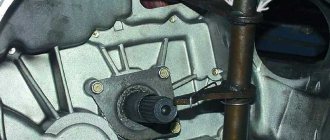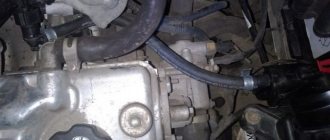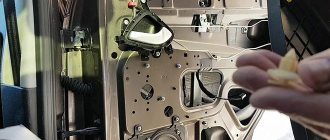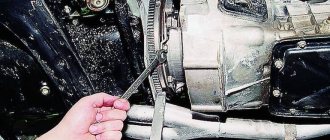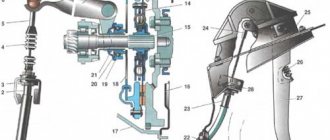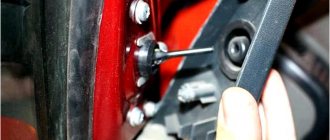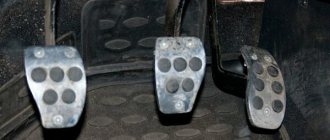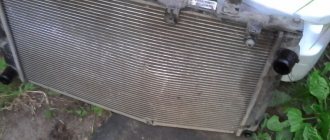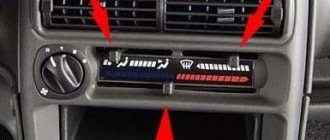The clutch is designed to connect and disconnect the gearbox and engine flywheel, smoothing out sudden changes in torque loads. The friction clutch allows the car to start and stop smoothly with the power unit running. If sudden braking is necessary with the clutch engaged, it slips, protecting the gearbox from possible overloads. In good condition, the mechanism should provide a reliable connection between the transmission and the power unit.
Features of correct adjustment of the unit
Quite often, clutch-related problems are solved by standard adjustments. However, such measures must be carried out based on the recommendations of specialists and experienced car owners. First of all, you need to turn off the engine. After this, just press the pedal several times and listen to the sounds. If no grinding or creaking is heard, then the adjustment continues.
If the Lada-Granta clutch pedal gets stuck or it moves jerkily, then its position needs to be adjusted. First of all, you need to completely squeeze it out with your hand. It is better not to use your foot, as in this case it will be much more difficult to feel minor jamming or, conversely, jerking at the moment when the lever returns to its original position.
If you manage to find out that the pedal twitches a little, then you need to arm yourself with a ruler and determine the distance from the floor to the pedal, or rather, the part that protrudes outward. After this, while continuing to hold the measuring device, the car owner must press the lever and wait until it returns to the same position. If the values on the ruler diverge or the distance is more than 14.5 cm, then in this case you need to make adjustments. It is worth noting that the full pedal travel should not be more than 146 mm. The cable guide cannot move in relation to the fork lever by more than 2.7 cm.
Which clutch is better to put on Niva 21214
Name: Svetochka Reg.: 06/28/2007 Messages: 280 From: MO, South-West, village. Petrovskoye Age: 50 Car: Niva 21310, 1.7 i, power steering, 2007, quartz
At first there was the same clutch, it was activated from the floor, the car did not move at all without gas. The gas was also hard, which made the acceleration somewhat sluggish. The car in a traffic jam constantly stalled or roared. With my “talented driving” at a crossing, six months later there were already symptoms of a scorched clutch (the car was jumping), I told the mechanic at the MOT, he immediately changed it to a Valio. And the throttle cable was adjusted and lubricated. Now the colossus rides in a traffic jam on one clutch, starts with half a kick and the acceleration has become much better. With one gas pedal you can give the car different speeds, the pedal has become so gentle, I can feel the speed. I'm happy as an elephant. And traffic jams are not a problem for me now
Types of faults
All types of clutch malfunctions installed on Grants are divided into the following groups:
- The clutch cannot be completely disengaged. The reasons for this type of breakdown lie in incomplete pedal travel, vibrations and possible jamming in the driven disk hub, warpage and distortion in the pressure disk, loose rivets and faulty friction linings. In addition, such a problem is often caused by a malfunction of the drive cable, a breakdown of the compensation mechanism, or disturbances in the mechanism that compensates for the wear of the driven disk linings.
- The clutch cannot be fully engaged. This breakdown can occur due to wear of the friction linings or due to their oiling. Other reasons for this malfunction include an oily surface of the flywheel and clutch basket and jamming (or damage) on the clutch drive.
- The clutch works with jerks. This violation is caused by oily friction linings, as well as an oily flywheel and clutch basket, a stuck drive and a damaged pressure plate surface.
- An increase in noise level when the clutch is engaged is caused by a malfunction of the damper springs.
- An increase in noise level during clutch disengagement is caused by a leak from the release bearing, as well as its damage or wear.
As a rule, if the clutch pedal fails and clicking and creaking sounds are detected during its operation, most often you just need to replace the clutch cable. Exactly how this procedure is performed will be discussed below.
New developments
Nissan plans to completely eliminate mechanics between the steering wheel and wheels; it will be replaced by electronics. This system is called “steer-by-wire”.
European designers are working on creating dual-mass flywheels with a pendulum system. Here 3-4 details that self-define in space should be added. By moving in antiphase, they should dampen vibrations more effectively. There are several options for placing such parts: inside or outside the flywheel, as well as on the basket body. The Germans have already released the first samples with this type of clutch.
Replacing the cable
To change the cable, you need to carry out a number of simple operations:
in the car interior (under the panel), the nut that secures the cable to the pedal assembly is unscrewed;
the braid stopper is removed from the pin;
- use pliers to remove the locking bracket;
- the pedal axle is removed;
- the pedal bracket spring is also dismantled;
- use pliers to pull it towards you and remove the tip stop;
- the pedal is released from the cable end;
- the cable sheath seal is removed (in the engine compartment);
- the tip of the cable connected to the plug must be pulled forward towards you and pulled out of the groove;
- dismantle the tip driver;
- remove the guide bushing;
- pull the Lada Granta clutch cable through the hole between the engine compartment and the car interior.
Before installing a new cable, it must be lubricated. To do this, a little machine oil is poured between it and its shell. Install the new cable in reverse order
It is impossible not to pay attention to the imperfection of the cable tension mechanism. The reason for its squeaking may be:
- plastic bushing on the pedal;
- plastic leash;
- cable (cable and its sheath);
- gearbox input shaft.
Most of the reasons can be eliminated very simply - you need to lubricate the rubbing parts, for example, with lithol. The same applies to the input shaft - creaking occurs due to lack of bearing lubrication. To lubricate it, you need to get to the fork boot and, pulling it back, generously pump graphite lubricant inside.
The clutch of the Lada Grant remains the same as before. Exactly the same single-disk mechanisms were installed on previous models - Priora, first-generation Kalina, VAZ 2110, 2109, 2108. The plant only partially modified the design, providing it with higher quality parts. Additionally, an automatic cable tensioner has appeared, which in itself is an additional source of malfunctions. This is a fairly old development, and during its use no measures have been taken to eliminate the most common problems. On the contrary, engineers complicated the design by adding additional elements. On the other hand, the Lada Granta clutch is inexpensive to maintain, and you can buy all the necessary spare parts in every car store. Any car owner can replace the Lada Granta clutch with his own hands. Availability and simplicity of design remain AvtoVAZ’s priorities, although quality is not in first place.
The Lada Granta is a popular domestic car that has been successfully sold throughout the Russian Federation and even abroad for many years. Any car has its weak points, and over time, certain components of a complex design may break down. The operating conditions of the car are important. For example, when driving on bad roads or during periods of active use of reagents, car owners have to face a number of problems.
The clutch on a Lada Grant can fail at the most inconvenient moment. Therefore, it will be useful to find out how you can adjust this unit yourself, and when it needs to be completely replaced. Let's take a closer look.
Reviews from car owners
If you look at the opinions of car owners about this component of the car, many note that it quite often creates problems. For example, some have to deal with tight pedal movement or the appearance of unpleasant crunching and clicking noises.
However, few people have to buy a complete clutch kit. Often a specific detail is enough. Therefore, most often it is enough to install a new cable or lubricate the jacket. Accordingly, even if this unit fails, repairs will not be as expensive as it might seem.
In general, car owners are satisfied with this car. It is inexpensive and does not require special care. If you do not use it in extreme conditions, then there should be no problems. It also performs well on difficult roads. Many note that modern foreign cars at the same cost have much worse characteristics. But the opinions of car owners may be divided. Some people are not ready to exchange their Lada for anything, while others are happy to switch to another car.
How is the clutch adjusted?
So, how to properly adjust the clutch? The clutch of the modern VAZ model family has a clutch cable, along with which there are ratchet mechanisms in the structural unit. These cables do not provide for any clearance, which in theory does not imply the need for adjustment. However, the manufacturer insistently recommends performing periodic adjustment procedures on this mechanism.
To perform the adjustment on these cars, including the Lada Granta, you should stock up on a ruler (a caliper is also suitable) and a screwdriver.
The sequence of manipulations looks like this.
Open the hood of the Lada Grant and install the clutch cable in its original position. To do this, move its lower edge forward until it stops. By moving the cable, you can feel the force created by the return spring. We do not pay due attention to this aspect and continue this manipulation. Taking a ruler or the same caliper, we measure the distance. The photo clearly shows the segment to be measured: between the beginning of the fork and the cable lead. For correct measurements, you will need to keep the cable in a stationary and certain position. The ideal measurement result would be 27 mm. When clutch adjustment is required, the actual parameter will differ from the stated standard. To achieve the required value (27 mm), rotate the cable lead. Having completed this action, insert the cable end into the groove of the fork, and then release the retained element
Please note that there is no gap. This completes the procedure. Now let's move on to pressing the pedal multiple times to make sure the unit is functioning correctly
After completing a set of presses, we once again measure the distance along the cable and, if discrepancies appear, perform repeated adjustments.
The need to adjust the cable on Lada Granta, Kalina or Priora occurs regardless of its condition (new or has already spent a certain amount of service life).
When does the need for adjustment occur?
In such cases:
- when there are jerks from the start that are permanent;
- when an attempt to engage a gear is accompanied by a blow;
- if the pedal is stuck.
These are the most striking symptoms indicating the need for adjustment. Ideally, the level of the pedal should coincide with the brake. In this case, the full pedal travel is 125 - 135 mm. Practice shows that the stroke can be exceeded by up to 160 mm.
To properly adjust the pedal assembly, you will need to stock up on two wrenches with suitable parameters.
- Loosen the locknut holding the cable. It is located on the engine compartment side.
- Now use a wrench to rotate the second locknut to achieve the correct clearance.
- Upon completion of the process, be sure to tighten the first nut to the required torque.
We remind you that efforts should be made to achieve a uniform level in the pedal assembly (the author of the video is Time R).
Review of Manufacturer Prices
| Manufacturer article number | Price, rub.) | Resource (Thousand km) |
| Set of wheels LADA 2190-316010001 | From 3100 | 85 — 105 |
| —/— 2190-31601000 | —/— | —/— |
| —/— 302050901 | —/— | —/— |
| —/— 302052223 | —/— | —/— |
| —/— 302052307 | —/— | —/— |
| LADA 21810160118001 clutch | From 650 | 80 |
| LADA 21090160119000 input shaft guide | From 750 | 75 — 80 |
| LADA 21010160121500 fork support | From 150 | 75 – 95 |
| LADA 21810160120001 plug | From 800 | 85 – 95 |
| Connecting spring fork and clutch 21010160118800 | From 350 | 85 — 95 |
*prices are current as of October 30, 2018.
Recommendations for the selection of parts and components
The vast majority of spare parts are provided by domestic manufacturers. Foreign analogues are 10-17% more expensive. The manufacturing quality of the parts is approximately at the same level.
In order to prevent the purchase of counterfeits, use the services of official representative offices, dealer centers, and authorized service stations.
Lately, ordering parts with their subsequent installation directly in workshops has become popular. The advantages of this choice are professional installation, prompt delivery, and a guarantee.
Lada Granta clutch diagram
List of online stores selling parts (Moscow, St. Petersburg, Kyiv regions)
| № | Name | Address |
| 1. | "VIN code" | VIN-code.rf/ |
| 2. | "Avtopiter" | https://www.autopiter.ru/ |
| 3. | "DvizhCom" | https://dvizhcom.ru/ |
| 4. | "BaltKam" | https://www.baltkam.ru/ |
| 5. | "Elite" | https://eshop.elit.ua/ |
| 6. | "Clan" | https://klan.com.ua/ |
Why did it happen so?
Perhaps the automatic requests do not belong to you, but to another user accessing the network from the same IP address as you. You need to enter the characters into the form once, after which we will remember you and be able to distinguish you from other users exiting from this IP. In this case, the page with the captcha will not bother you for quite a long time.
You may have add-ons installed in your browser that can make automatic search requests. In this case, we recommend that you disable them.
It is also possible that your computer is infected with a virus program that is using it to collect information. Maybe you should check your system for viruses.
If you have any problems or would like our support team, please use the feedback form.
Replacing the clutch on a Lada Granta takes from 3 to 8 hours. Replacing the Lada Granta clutch is done only with the removal/installation of the gearbox. On some models, to remove the box you need to remove the subframe. It is best to determine what exactly to change: the disk, basket or release bearing after the box is removed.
The decision to replace the clutch on a Lada Granta must be made after diagnostics at a car service center. Some symptoms may be similar to a faulty transmission or gearshift mechanism. On robotic gearboxes (robot, isitronic, etc.), after replacing the clutch, you will need to adapt the grip point. This can be done at our stations.
Cost of replacing a clutch on a Lada Granta:
| Replacement options | Price |
| Replacement of clutch Lada Granta, manual transmission, gasoline | from 4500 rub. |
| Replacement of clutch Lada Granta, manual transmission, diesel | from 5000 rub. |
| Lada Granta clutch replacement, DSG, robot | from 8000 rub. |
| Clutch adaptation of Lada Granta | from 2500 rub. |
| Removal/installation of Lada Granta subframe | from 3000 rub. |
If you notice that the clutch begins to behave differently than before, we recommend that you immediately contact a car service for diagnostics. If you start this moment, then subsequently, in addition to replacing the clutch on the Lada Granta, you will also have to replace the flywheel. And the cost of a flywheel is several times higher than the cost of a clutch kit.
When replacing the clutch, we also recommend replacing the crankshaft rear oil seal and replacing the axle shaft seals
When replacing a clutch, a good mechanic will always pay attention to the condition of the gear selector rod seal. The cost of seals is minimal and it is better to do everything at once without overpaying for the same work in the future
Why is the pedal hard on the new clutch?
If a car owner purchased a new clutch kit for a Lada Granta, then he may encounter such a problem. The fact is that many people prefer to save money and purchase spare parts from Chinese manufacturers. Those, in turn, deliberately increase the stiffness of the leaf spring. Why is this being done? Everything is elementary. Such manipulations are carried out in order to increase the working life of the unit, which itself has worse characteristics compared to factory analogues.
Therefore, when replacing the clutch on a Lada Grant, it is worth purchasing higher quality parts. It is better to buy all elements from the manufacturer.
How to choose a clutch for a VAZ according to your driving style
When choosing a clutch, you need to take into account your driving style.
Calm driving style - low revs, smooth shifts, not harsh acceleration. Suitable kits from manufacturers:
- Luk - gears shift smoothly, no jerking.
- Valeo - soft clutch for a comfortable ride.
Most motorists drive at medium speeds, occasionally accelerating in traffic. The style is standard. Suitable mechanism from manufacturers:
- KraftTech - a coupling for comfortable movement.
- Sachs - a tighter device than previous options, suitable for many drivers.
- “VIS” is a domestically produced system, manufactured with high quality, and does not tolerate sudden movements.
With a dynamic driving style, sharp shifts and “throwing” of the clutch pedal are possible. The coupling experiences heavy loads, the following kits are suitable:
- Pilenga - recommended without metal ceramics. The clutch is hard, to avoid jerking you need to pick up high speeds and shift quickly.
- Sachs - suitable for many.
Some motorists prefer a sporty driving style when the mechanism is under stress. The same kits are suitable as for the dynamic style. The clutch will have to be changed more often.
When choosing a coupling, you need to take into account factors: cost, compatibility of the kit with the vehicle model, and operating features of the machine.
Among owners of VAZ cars, it is common to install the entire Sachs kit, except for the release bearing, which is replaced with a factory one.
Driving style and clutch: choosing a set
Still haven't figured out what to buy to replace the coupling? Let's look at one more aspect - driving style, because each of us prefers to move in a manner unique to him. Conventionally, we divide the number of driving styles by four. Based on reviews and operational experience, we will try to create sets of companies that would correspond to a particular driving style. Thus, we will try to answer the question, which clutch is best installed on the VAZ 2114 and why.
Calm style
This driving style provides low revs, smooth shifting and the same acceleration. Products from the following brands are suitable here:
- Luk is a reliable kit that provides smooth and comfortable shifting without jerking.
- Valeo is a comfortable kit, it shows its best sides in traffic jams, there is a good reserve of torque.
Standard style
- KraftTech is a fairly comfortable set with an average service life.
- Sachs is a moderately tight clutch for such driving with a good reserve of torque, allowing you to ride in both an active and relaxed manner.
- VIS is a domestic product of good quality, but is sensitive to clutch control experience.
Dynamic style
Involves rapid acceleration and sharp gear changes with constant clutch throwing, which operates at high speeds most of the time. In this case, the following kits are suitable:
- Pilenga – use the kit not with metal ceramics. The stiffest clutch, in order to avoid jerking, you have to raise the speed and quickly release the clutch.
- Sachs is the best kit for this type of riding, moderately tight with minimal jerking.
Clutch selection | Topic author: Fumo
I apologize for creating such a topic, I want to know what is better to put? I drive fast, sharply)
Alexey (Bishamon) I change the clutch every year and a half.
Alexey (Bishamon) Alexey, don’t forget to buy a release spring. It is not included in the kit. Price 5 rub. And this is a completely normal clutch. I have two years and the flight is normal.
Alexey (Bishamon) Okay, I’ll take that into account. Thank you!
Alexey (Bishamon) And the mileage is 60 thousand, already changed twice
Artem (Deepa) I drive a Kraft. ok...nothing to compare with yet.
Alexey (Bishamon) There are legends on the internet about the toughness of Craft. When you have the opportunity to compare, let me know.))
Artem (Deepa) Alexey, definitely. but I hope not soon.
Aydar (Sisel) Alexey, I installed craft, for the first two days I couldn’t get going) but then I got used to it) so far everything is fine)
Alexey (Bishamon) Aidar, in the summer when it’s hot, if it starts to twitch, change it right away, don’t wait until the release valve falls apart.
Sergey (Giladah) I changed the clutch myself, I even removed and installed the box myself.. Replacing the clutch in our service costs 4000 rubles. It’s free and high quality (when I was changing it I noticed that the bolts securing the box were not tightened). And how nice it is to drive a car that you made yourself!
Alexey (Bishamon) My clutch constantly jerks in the heat. You change it, drive it for a month and it starts jerking again when you start. Could it be the flywheel?
Alexey (Bishamon) Alexey, these are either springs or a basket. As a result, the clutch still dies from this hammering. Install a normal set, don’t buy Craft or anything cheap. and forget it.
Pavel (Hadasa) is it possible to put the clutch disc from the Niva on the seven? please advise?
Alexey (Bishamon) Pavel, what kind of question? https://avtopasker.ru/catalog/index.php? search=? 4?? 4?? ..
Vlad (Sylvia) people, started the car, turned on the clutch, it fell down and the gear does not engage, and when the car is not started, all the gears work, and every other time the clutch pedal returns when turned on, what is this.
Alexey (Bishamon) Vlad, what did the check and adjustment show? https://car-exotic.com/vaz-cars/vaz-lada-2107-auto-rep.. Although if you say that the pedal has fallen, then the GCS needs to be changed. Didn't change it? . Or look where the liquid leaked.
Vlad (Sylvia) Alexey, ok
Nikolay (Cornell) I drove a craft about 4 years ago, it was hard and the release was either defective, or it was really shitty, it whistled and didn’t run a thousand. Since then I have had a negative attitude towards him. Plus, it’s true that everything was there, the right-handed plastic convenient one was included in the kit, well, to center the disk, I still use it)
Why the ECM detects error “P0830”, video explanation
Praise to the author! I am also a terrible car enthusiast, albeit with little experience... I also had right-hand drive ones, but unfortunately, they are not convenient with our traffic. I now have probably the most boring Toyota model. For almost 2 years of owning this car, I had no problems at all, it burned out once a light bulb in the foot, and I changed the brakes and oil according to plan, despite the fact that the car is 8 years old, the mileage is about 150 thousand. It accelerates quickly, drives smoothly, and is maneuverable. spacious trunk and for its size a very comfortable and spacious interior, dad feels completely comfortable in the back seat, and he is a large man. After a night in a windswept parking lot at minus 35, it started up and didn’t even sneeze once. The stove heats perfectly, the air conditioner cools quickly, the consumption is 6-7 liters of 92 in the city. engine 1.5. 106 horses, + with its size it will fit into any hole in the parking lot. In short, the car is just great. )))
I've been meaning to adjust the clutch on my Grant for a long time. I made a printout of your article. Tomorrow I’ll arm myself with the necessary tools and go to the garage to do everything with my own hands step by step, as described in the article.
Open the hood, under the air filter there is a clutch foot. It is equipped with a cable with a plastic screw. Lightly pressing the foot, remove the cable to the side. We adjust the cable screw and put it back on the foot.
When accelerating, the engine roars slightly when the leveler revs up
Clutch needs replacement! It's slipping!
When starting off there is jerking, what could be the problem?
Replacement clutch disc
I sharpened the flywheel! and he was crooked. so you can’t get away with just one disk
The clutch cable broke. I went and bought a new one. Changed it. While I was driving, the clutch was soft; accidentally, in 4th gear at 90 km/h, I jumped into 3rd gear instead of 5th. But nothing. An hour later, I noticed that when changing gears, my car seemed to be giving up gas (by the sound), but in fact I don’t know what it is. The clutch pedal has free play, i.e. hanging out. And the pedal is too soft. Can there be different clutch cables on the grant?
The clutch is designed to connect and disconnect the gearbox and engine flywheel, smoothing out sudden changes in torque loads. The friction clutch allows the car to start and stop smoothly with the power unit running. If sudden braking is necessary with the clutch engaged, it slips, protecting the gearbox from possible overloads. In good condition, the mechanism should provide a reliable connection between the transmission and the power unit.
"Lada Granta": how manual transmission works and works
In the manual transmission, all mechanical drives for controlling speed selection have been eliminated and replaced with electric ones. This made it possible to get rid of rods and cables, improve the sound insulation of the interior and place all the drive units of the mechanical elements of the transmission on the gearbox. Only the electronic control unit for controlling the operation of the electric motors in the actuators (actuators) is connected to the joystick in the cabin.
Differences from manual transmission
With a manual transmission, gear changes are initiated by the driver through the rocker or using cables. This requires additional mechanical components that are subject to misadjustment and breakdown, and also contribute to increased noise levels in the cabin.
Robotic gearbox design
The robot box is connected to the passenger compartment by electrical wires, which eliminates noise and vibration and simplifies control, providing two modes of operation - automatic and manual.
Clutch diagram of manual transmission "Lada Granta"
The Lada Granta clutch with a robot gearbox differs from a conventional mechanical one by replacing the drive units (clutch pedal in the cabin and the gear selection mechanism) with electromechanical devices (actuators) mounted on the gearbox housing. At the command of the electronic control unit, they turn on/off the corresponding gears and clutch.
Signs of clutch wear
The following clutch elements on a Grant with a robot gearbox are most sensitive to wear: the driven disc and the release bearing.
Signs of wear on the driven disk appear in a weak response to acceleration when going uphill, if the car does not pick up speed when the engine speed increases. This is the result of the natural depletion of the life of the friction linings from long-term use or from increased loads on them during a sudden start.
Other signs of wear in the clutch mechanism may include:
- lack of smoothness when switching;
- noise when switching off;
- odor appears during short movement under load.
If wear is suspected, the clutch should be checked and faulty elements replaced. Replacing the clutch on a Grant with a robot gearbox will require further adaptation of the robot.
Possible clutch malfunctions
The clutch operates under difficult conditions; its elements may become unusable, preventing normal operation, which means they need to be replaced. Common malfunctions include:
- wear or deformation of the friction disc;
- breakage of the diaphragm spring petals;
- destruction of damper springs;
- wear of the friction disc engagement splines on the shaft;
- fork deformation;
- release bearing wear.
Basic clutch malfunctions
Normal operation can be prevented by oil from the gearbox getting onto the friction linings of the driven disk. If signs of malfunction are identified, it may be necessary to replace the clutch on a Lada Granta with a robot gearbox.
What is clutch actuator adaptation and why is it needed?
Adaptation is the updating of the positioning data of the clutch drive units in the electronic command unit. Due to wear and exhaustion of working elements, their linear parameters change, which must be taken into account by the robot program.
Frequency of adaptation
If the transmission mechanism has not been repaired or replaced, then adaptation is carried out as the transmission parts wear out on average after 15,000-20,000 km, preferably at each maintenance. Aggressive driving may require frequent adjustment of the Lada Granta clutch robot.
Fault indicators
If the transmission warning light comes on or the transmission does not shift correctly, adaptations may be required.
Is there a difference between planned adaptation and after replacing or repairing the clutch?
It makes no difference whether the clutch was replaced on a Grant with a robot gearbox, or whether the adjustment was planned, the algorithm of the procedure is the same. It consists of checking and remembering the positions of the gear shift actuators and clutch operation.
Scheduled replacement after a certain mileage or service life
The service life of the clutch depends on the conditions in which it is operated. The clutch life depends not only on the quality of the parts, but also on the driving style. Participation in racing, abrupt starts from a standstill at high speeds and incorrect clutch adjustment have a detrimental effect on its performance.
If you follow all the rules, then a planned replacement will need to be carried out after 100 thousand km. mileage If you violate the basic operating rules, then replacement will have to be carried out after 50 thousand km.
Signs of clutch problems will be noticeable while the vehicle is in use. The exact location of the breakdown can be determined after diagnostics. If you carry out scheduled repairs and replacements in a timely manner, you can avoid serious damage, the elimination of which requires large financial investments.
Good day, dear car enthusiasts! Each of us is always concerned about how long this or that part or car system will last. It `s naturally. Especially considering the quality of some products, the “skills” of workers, etc.
This issue fully concerns the car’s clutch. Very often on motorist forums there is a serious question about when to change the clutch, and how to know when the time has come to replace it. So let’s try to figure out together what the actual service life of the clutch is, and whether it exists at all.
Is there a certain clutch resource?
Whether or not you will be upset when you find out that the manufacturer does not indicate specific figures for clutch service life. If, for example, in the brake system, it is clearly stated that the thickness of the brake disc should be such and such, then why is this not applicable to the clutch?
The fact is that clutch wear depends on many reasons, and first of all, of course, on how the driver changes gears and in what mode the clutch is used.
And while clutch disc thickness cannot be measured the same way brake disc thickness can be measured with a caliper, there are ways to measure it. There are two of them.
- The first way to measure the thickness of the clutch disc is with a special measuring gauge. This method does not require dismantling the clutch; it is performed on a lift. But you are unlikely to use it.
- the second method is simpler to implement and allows you to determine the wear of the clutch disc in order to replace it. Replacing the driven disk is a procedure provided by the manufacturer, because The driven disk is a consumable part. The check is carried out as follows: with the engine running, you need to put it in high gear, accelerate it, and if the car does not stall, this means that the driven disk is worn out and requires replacement. It must be remembered that such a check of the thickness of the clutch disc is not technologically correct, but it is effective and allows you to determine the condition of the disc extremely accurately.
As already mentioned, the life of any clutch is determined by its operating conditions. Without going into technical details of the interaction of clutch parts, you should understand that basically the life of the clutch and the wear rate of the discs depend only on the driver.
A clutch of the same quality and manufacturer can last 5,000 km for one driver, and 100,000 for another. Participation in drag racing, frequent slipping, abrupt starting at high speeds, ingress of foreign liquids and objects, unqualified installation and adjustment clutch - all this reduces the life of the clutch.
How to check the clutch?
The clutch is checked using already proven and reliable folk methods, and only by them. Naturally, in addition to disassembling the clutch. We are talking about how you can check the clutch of your car yourself, and then decide whether you need a more in-depth diagnostic with dismantling the clutch mechanism.
So, let's start checking the clutch on the main points.
Clutch slippage. Those. again we are talking about wear on the driven disk when it is not fully pressed against the flywheel, which means there is no full clutch.
- We put the car on the handbrake and start the engine;
- engage a higher gear: 3rd or 4th;
- slowly depress the clutch and “give” the gas;
- When the handbrake is adjusted, the car engine should stall. If this does not happen, then it is time to think about replacing the clutch disc.
The clutch “drives” , i.e. it doesn't turn off completely. This malfunction is accompanied by difficult gear shifting, or extraneous noises and sounds when changing gears. And the gearbox is hardly to blame here. Checking the clutch.
- the engine is idling;
- Depress the clutch pedal completely and engage first or reverse gear;
- If the gear is engaged with uncharacteristic effort, and at the same time you hear extraneous sounds, then the driven disk does not completely move away from the flywheel, i.e. the clutch “drives”;
- you need to pump the hydraulics and adjust the free play of the clutch pedal;
- check again, if nothing has changed, then it’s time to go to a car service for a more in-depth diagnosis of the clutch.
Using these simple methods, you can independently check the clutch before it fails at the most inopportune moment. Timely diagnostics, and even better - correct operation, will increase the life of the clutch, or take timely measures to eliminate malfunctions.
Lada Granta car clutch
The clutch is single-disc, dry, with a diaphragm-type central spring. Located in an aluminum crankcase, structurally integrated with the gearbox and attached to the engine cylinder block.
| rice. 1 |
The clutch housing is connected by six bolts to the engine flywheel. The flywheel has three pins, which, when installing the clutch, fit into the corresponding holes in the housing, centering it. The casing is connected to the pressure (drive) disk by three pairs of elastic steel plates. The complete basket is balanced on a stand, so it is replaced entirely. Replacement of the basket is necessary when there is ring wear on the pressure spring petals to a depth of more than 0.8 mm, as well as when there is significant wear on the surface of the pressure disk or “settlement” of the spring.
| rice. 2 |
The driven disk with a spring-loaded torsional vibration damper is located on the splines of the gearbox input shaft between the flywheel and the pressure plate. The driven disk is replaced if it has axial runout in the area of the friction linings, weakening of the rivet joints, and also if the rivet heads are recessed from the surface of the linings by less than 0.2 mm.
| rice. 3 |
The clutch drive is a cable drive, backlash-free with automatic adjustment of the cable length. A plastic leash is screwed onto the threaded end of the cable, which is inserted into the clutch release fork lever. During the operation of the vehicle, the linings of the driven disk wear out, as a result of which the clutch release fork lever moves forward (as the vehicle moves). Since the cable is connected to the fork lever, the length of the cable must be increased when the linings wear out to maintain normal travel of the clutch pedal. The cable length is changed automatically using a regulator located in the upper end of the cable and connected to the clutch pedal. Therefore, during operation, adjustment of the clutch cable is not provided.
| rice. 4 |
The automatic cable length adjustment mechanism consists of a plastic housing into which a toothed cable tip is inserted and held in the housing by two spring-loaded clamps. The mechanism also includes a spacer sleeve placed on a cable, one end of which fits into the mechanism body.
| rice. 5 |
When the pedal is pressed, the spacer sleeve moves away from the cable sheath bracket and does not press on the mechanism clamps. In this case, the mechanism body is rigidly connected to the cable. If the driven disk linings are not worn out, then when the pedal is released, the bushing only touches the bracket and does not release the clamps - the toothed tip of the cable does not move relative to the body. As the linings wear, the clutch release fork lever with the threaded end of the cable moves forward (in the direction of the vehicle), tensioning the cable. In this case, the spacer sleeve, resting against the bracket, releases the spring-loaded clamps, and the toothed tip of the cable moves out of the housing by the amount necessary to compensate for the wear of the linings.
The clutch pedal is mounted on an axle in the pedal assembly bracket. A clutch release bearing with housing assembly is installed between the clutch release fork and the pressure spring petals. The bearing housing is pressed against the fork legs by a spring clip. The bearing moves freely along a guide sleeve mounted on the clutch housing. When you press the clutch pedal, the cable acts on the clutch release fork lever, which moves the bearing. The bearing presses on the clutch pressure spring leaves, causing the pressure plate to move away from the flywheel, allowing the engine crankshaft and transmission input shaft to rotate independently of each other.
Friction clutch device
The manufacturer installs the same clutch on the Lada Granta as on the Lada Kalina. The mechanism consists of a flywheel with a basket attached to it. The task of the latter is to continuously press the disk with linings made of friction material - this is how the torque from the engine is transmitted to the transmission. A cable-type clutch means that when the pedal is pressed, the cable connected to the clutch fork becomes taut, the paddles stop pressing the disc, and torque from the engine is not transmitted to the gearbox.
The clutch on the Grant has one disc; it is frictional with a central spring in the form of a diaphragm. It is located in a special aluminum crankcase and combined with the gearbox in one housing, attached directly to the cylinder block. For clarity, you can see a detailed drawing of the device.
Lada Granta clutch device
- Drive cable.
- Outer braid of the cable.
- The end of the cable braid is lower.
- Dust cover.
- Metal leash.
- Fork bracket.
- Bearing sleeve.
- Release bearing.
- Casing.
- Diaphragm spring.
- Disk (master).
- Flywheel.
- Friction material linings on the disc.
- Disk (slave).
- Damper spring.
- Rotation vibration damper.
- Disc hub (driven).
- Central spring.
- Cable end.
- Automatic cable tensioner housing.
- Sleeve.
- Fastening the cable braid.
- Pan (crankcase).
- Gearbox input shaft.
On the Lada Grant, the clutch does not require additional adjustment during its entire service life - this is what is written in the car’s operating manual.
What is this?
By the clutch on a Granta car, motorists and service station technicians understand the mechanism that serves to transmit torque and dampen torsional vibrations. When shifting gears, this unit disconnects the motor from the gearbox and then makes a smooth connection. The spare part is located between the internal combustion engine and the gearbox.
Structurally, the part consists of the following elements:
- Shutdown plug.
- Flywheel.
- Driven disk.
- Pressure disk.
- Gearbox input shaft.
Clutch failure cannot go unnoticed. If this car part fails, the driver will observe the following:
- Incomplete engagement/disengagement of the clutch.
- Vibration when turned on.
- Noise when turned off.
- Jerks when changing gears.
- Increasing pedal free play.
If such signs appear, you should visit a service station. Most likely, the car service technician will offer to replace the car part.
REQUIREMENTS AND SUGGESTIONS
The new product, which is installed on the “Norma” and “Lux” versions, is based on the same gearbox that appeared on the VAZ-2108 and, with minor upgrades, has survived to this day. Its weaknesses are well known: difficult activation, large lever strokes, smeared switching pattern, low vibration comfort.
Figuring out what and how we could improve, we agreed on one thing: not to touch the gear part, namely the shafts, gears, and synchronizers. Otherwise, huge financial costs will be required to launch a new gearbox into production - without high-precision equipment, it will not be possible to ensure the proper quality of engagement, operation and synchronization.
Removing the clutch
Replacing any part begins with dismantling the old one. When performing this manipulation, the car must be placed on a lift, after which the gearbox is dismantled. Then you should mark the marks on the flywheel, and the bolts securing the clutch should be unscrewed; at this time it is recommended to hold the flywheel with a screwdriver. Next, the clutch basket is removed from the engine flywheel together with the driven disk.
The final stage of work is removing the release bearing. First, pry up the ends of the spring holding it with a flat-head screwdriver, and then remove the part from the guide sleeve. Next, the bearing and coupling itself are removed, then the spring that previously held it should be removed.
Why has the clutch pedal become stiff?
If the car is completely new, then the so-called drive wedge may have occurred. This is the easiest fault that you can adjust yourself. But if we are talking about an older car, then perhaps the problems are more serious and affect the entire unit.
Most often, such problems occur due to poor performance of the diaphragm spring. It is possible that the fork is jamming or the bearing being pressed out is jammed. Cable scuffing often occurs. The driven disk itself may also become jammed.
If the car is in use for a long time, then cracks may appear on the drive fork. You also need to understand that over many years of driving a car, a large amount of dirt could simply accumulate in this unit.
Pricing factors
Car repairs are always accompanied by certain financial costs. In addition to purchasing a serviceable part, the car owner will have to pay the technician for the service of installing it. Therefore, today many motorists are trying to save money. To do this, they visit a number of sales locations and analyze the price range.
It is not recommended to take the cheapest spare part: most likely, its quality is low. You need to understand what factors influence cost in addition to quality. The price depends on:
- States.
- Varieties.
- Brenda.
- Originality.
- Places of purchase.
- Delivery prices.
The more famous the manufacturing company, the more its spare parts will be sold at a higher price. The better the condition of the part, the higher its value will be.
According to the control method, the clutch is:
- With hydraulic.
- With mechanical.
- With electric.
- With a combined drive type.
There are spare parts for the switching mode:
- Constantly closed.
- Not permanently closed.
Clutches are classified according to the type of friction:
- Wet (parts operate in an oil bath).
- Dry (elements operate in air).
Depending on the number of driven disks, a car part can be:
Based on the location of the pressure springs, spare parts are distinguished:
- With a peripheral location.
- With central diaphragm spring.
According to the condition, a spare part for a Grant can be:
- New.
- Old, restored.
- Used, unrefurbished.
Various companies produce this part. Therefore, we can highlight the clutch on the Grant:
A non-original device is sold under the following brands:
You can buy a clutch for Granta in different places. For example:
ROPE DRIVE
Despite the simplicity and low price, almost all manufacturers abandoned the rod drive, like on the old box. Today, designs of several rods with complex scenes are used to dampen vibrations on the lever, or a more expensive and convenient cable drive. AVTOVAZ experimented with the latter back at Samara, purchasing parts from. But with the switching mechanism located at the bottom, the performance of such a circuit is problematic, and the price of components was scary at that time. Work on the cable-driven gearbox continued as part of other projects, but the production model could only be realized now.
Clutch cable adjustment
Adjusting the clutch of the Lada Granta begins by pulling the tip of the cable in the direction of its movement, taking into account the fact that the spring will create force. You should fix the cable in this position and start measuring from the front edge of the plastic leash to the clutch fork lever. It should be no more than 2.7 cm. Since there is not much space under the hood, you should prepare a piece of wire of the required length (27 mm) in advance and measure the distance with it.
The leash rotates to adjust the tension. After the clutch cable is released, you need to eliminate the gaps between the driver and the fork lever. Next, the friction clutch pedal is depressed several times - this is how the auto-adjustment mechanism takes its working position - the pedal should not be tight or fall through.
Finalization
Purpose: install a gasket between the clutch cable and the gearbox fork
Procedure:
- Remove the clutch cable end from the fork.
- Unscrew the cable end, having previously measured the length of the free threads.
- Remove the clutch cable boot.
- Remove the rubber insert from the cable stop (photo No. 1).
- Instead, install a round washer made of porous rubber (diameter 32-35 mm, hole 12-13 mm) (photo 2).
- Cut a piece of rubber measuring 20x70 mm, 2.5-3 mm thick.
- Glue it (for example, with “Moment” glue) to the plastic cable stop (one turn), secure with electrical tape 1.5 turns.
- Insert the cable into the bracket on the gearbox and put on the boot.
- Screw on the tip, leaving a couple of millimeters less free threads on the stud (since the new gasket is thicker than the factory part).
- Place a 2 mm foam rubber spacer between the cable tip and the fork lever.
- Adjust the clutch pedal.
As a result: the effect was noticeable immediately. Now the rattling can only be heard with the windows open. After modifying the clutch cable fastening, the car drove more than 15 thousand km, the gearbox noise was within normal limits. Increased vibrations and noise are noticed only at a temperature of -20 o C, when the rubber gaskets become hard. The author has posted sound files (engine acceleration-braking mode at 1500-2000 rpm in 3rd gear), which shows what the noise was from the gearbox before and after modification. Site users can download the file:
Clutch kit VALEO VAZ Priora, Granta, Kalina-2, Vesta /cable gearbox VAZ 2181/
- We guarantee fast processing of your order during business hours (we work from 11-00 to 20-00, Saturday and Sunday are days off).
- We guarantee reliable packaging of your order (when sending it by Russian Post or transport company).
- We guarantee the fastest possible dispatch of your paid order (within 2-4 business days after receipt of payment).
- We guarantee a refund or exchange for another product (with recalculation) within 14 days from the date of receipt of the order (the product must be in good condition, without traces of installation, delivery costs are not reimbursed).
- We guarantee a free exchange of goods (transportation costs at our expense) if the purchased goods turn out to be defective.
Pickup in Moscow
- Description
- Reviews
APPLICABILITY: VAZ 2170, 2171, 2172 (Lada-Priora), VAZ 2190, 2191 (Lada-Granta), VAZ 2192, 2194 (Lada-Kalina 2), LADA Vesta (LADA Vesta) with cable drive manual transmission VAZ 2181.
is one of the suppliers of clutch discs to the main conveyor
of AVTOVAZ
.
CJSC "LADA Image"
is a subsidiary of
OJSC "AVTOVAZ"
and its official distributor for the sale of spare parts for
LADA
on the domestic market, as well as in near and far abroad countries.
The main strategic goal in the work of CJSC "LADA Image"
is to provide consumers - owners of
LADA
with the necessary range of services for organizing the repair and maintenance of vehicles throughout the territory of their operation throughout their entire life cycle, including original spare parts at competitive prices, available in the right moment in time.
Every second car in Europe and every third car in the world is equipped with a Valeo clutch. With 1,100 kits and 700 individual parts (including hydraulic limit stops and sports clutches), Valeo continues to develop and expand its product range for passenger cars, light and heavy duty trucks, and agricultural tractors.
Valeo parts and kits are produced in 12 factories on 4 continents and sold in 80 countries. Valeo has been producing clutches for over 80 years. Vast experience, high quality and constant innovation provide Valeo with a leading position in this market. The Transmission Systems division produces complete clutch systems, replacement clutch kits and individual components.
The main advantages of Valeo:
— high-quality parts used during factory assembly and offered on the spare parts market;
— unique packaging with film that prevents the movement of parts and protects them during transportation.
Includes: clutch pressure plate, driven clutch plate, clutch release clutch.
Which clutch kit for Lada Granta, Kalina, Priora is better to choose
Depending on the year of manufacture and place of production, clutch kits from different manufacturers may be installed on LADA Granta, Kalina and Priora cars from the factory. The article presents the article numbers of these parts. At the end of the article there is a survey in which we determine the best clutch kit, and in the comments we leave reviews about the original parts and analogues.
- 21703160113000 "EVR" LLC, Tolyatti for VAZ 11186 engines
- 21703160113010 for VAZ 21116 and VAZ 21126 engines
- 21703160113030 (8450001037), Lada Holding GMBH Vienna (until 02.2018)
- 21703160113031 (8450100737), Valeo (from 02.2018 to 09.2019)
- 21703160113032 Valeo
- 21703160113033 (8450079153) Valeo
- 21703160113090 "TD OAT" JSC Tolyatti
- 21703160108500 "EVR" LLC Tolyatti (with pressure spring assembly) for VAZ 11186 engines
- 21703160108510 for VAZ 21116 and VAZ 21126 engines
- 21703160108530 (8450001036), Lada Holding GMBH Vienna
- 21703160108590 "TD OAT" JSC Tolyatti (with pressure spring assembly)
Clutch release
:
- 21810160118001 (8450003303), Lada Holding GMBH Vienna
- 21810160118081 "VPK" CJSC Vologda
- Valeo 8450108936 and 21703160100001 (with VPZ coupling)
- "EVR" 21810160100000 and 21703160100000
- Luk 620331900
- Sachs (old 3000951033, new 3000950097)
The items are suitable for LADA cars with a 1.6 liter VAZ engine. and VAZ transmission (manual transmission, AMT or robot).
What brand of clutch do you recommend? How long did it take to replace the factory clutch?
Source
Clutch installation
Before you begin assembling the clutch, you must wash each removed element in kerosene. Then apply a thin layer of CV joint-4 lubricant to the guide sleeve of the release bearing and to the spline of the input shaft. The installation of parts begins with the release bearing, after which the clutch fork, spring and bushing are installed.
Next, the clutch is centered using a special frame inserted into the hole in the crankshaft end, while the driven disc is placed on the frame so that the protrusion located on the hub faces the gearbox. After this, the clutch basket is installed, and the centering frame is removed. Then you will need to install the gearbox in its proper place.
After installation, check and monitor the gear shifting process; they should turn on clearly, without clearly audible extraneous crunching sounds. In addition, ideally the car will move away without jerking.
Hydraulic clutch
Judging by the name of this type of clutch, I think it has become clear to you that in a hydraulic drive all forces, starting from the clutch pedal and ending with the mechanism itself, are transported using such a fluid. It, in turn, is placed in hydraulic cylinders and tubes that connect all the elements necessary in the mechanism. The construction mechanism of a hydraulic clutch is not very similar to a mechanical clutch.
One fairly large disk is located at the sharp end of the drive shaft and a steel casing. The casing is attached to the flywheel. Inside the casing there is a spring with radial petals. They are, let's say, release levers. The control pedal is located on the axis. It is raised to the body, namely to the bracket. The master cylinder pushrod is attached to the clutch pedal via a hinge. The pedal is released when the clutch is disengaged and the gear is changed.
How to replace the cable in the clutch mechanism?
How to properly replace a clutch cable? Below are detailed aspects of the instructions to successfully replace the cable.
- First, we begin to unscrew the cable nut from the bracket, which is located under the dashboard. We perform this action using the key set to “8”, after which access to dismantling the bracket stop appears.
- We disconnect the locking bracket, which is located on the “finger”.
- Next, remove the body of the compensation device (use a screwdriver).
- We remove the fluoroplastic bushing from the pedal pin.
- We visually monitor the assembly element for wear. If such “artifacts” are present on the surface of the bushing, then we definitely replace it by pre-treating it with grease.
- We dismantle the cable seal, which is mounted in the technological hole of the frontal shield of the body (in the photo it can be seen from the engine compartment).
- Pull the cable end as you move until it is removed from the fork groove.
- Using the key “17” we “defeat” the nut by means of which the cable tip is held on the corresponding bracket of the transmission unit. To prevent the tip from turning, we use an additional key.
- Now we proceed to dismantling the cable end, after which we remove this element from the hole. The cable itself can also be removed.
- Having completed the indicated manipulations, we begin the installation of a new unit.
- First, we pass the cable into the previously designated hole in the front shield.
- We treat the bushing with a special compound and fix the wear compensation element on the corresponding pin.
- Now we attach the cable directly to the pedal and return the previously removed seal to its place.
- We move on to installing the tip on the LADA Granta transmission bracket. Screw the retaining nut with the required torque (do not overdo it).
- We remember the need to tighten the leash.
- We continue the installation procedure by moving the lower tip in the forward direction until a feeling of stop occurs.
- We hold the tip in the designated position and at the same time measure the distance that was illuminated by us earlier (more specifically: in the “leash-fork” section). If the parameter is incorrect, rotate the leash until the optimal value appears.
- We remember the need to lubricate the body of the leash before installing it in the knot. The surface in contact with the fork must be lubricated.
- The final action is to press the pedal to its full value multiple times. Then we again make a control measurement in the “fork – leash” sector and, if it deviates from the regulations (27 mm), we make a re-regulation. This completes the clutch cable replacement.
Preparation for repair
To remove and subsequently replace the clutch, prepare a set of tools consisting of:
- center punch;
- extension cord;
- funnels;
- heads (8, 10, 15, 17, 19 and 30 mm);
- high head (13 mm);
- heads Torx E12 and Torx E14;
- Phillips and flat screwdrivers;
- pliers;
- curved spanners (8 and 13 mm);
- straight spanners (17 and 19 mm);
- two adjustable stops;
- metal brush;
- ratchet wrench;
- caliper;
- stands;
- hammer;
- jack;
- balloon wrench;
- torque wrench;
- centering mandrel.
